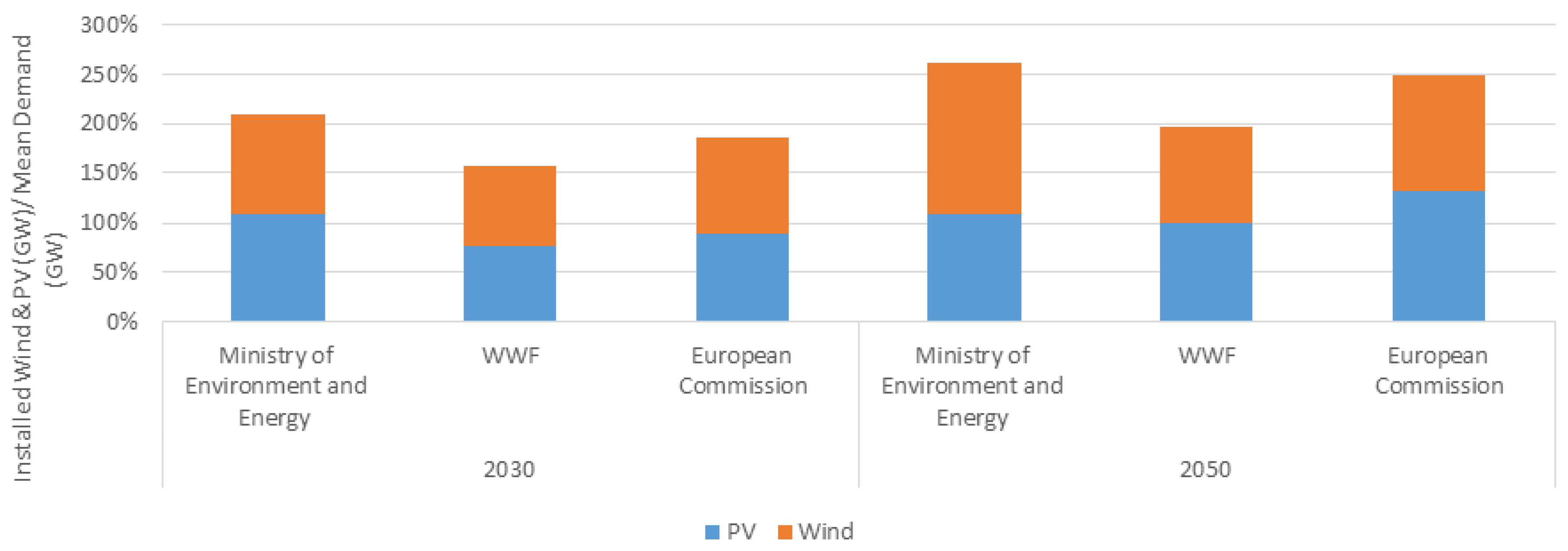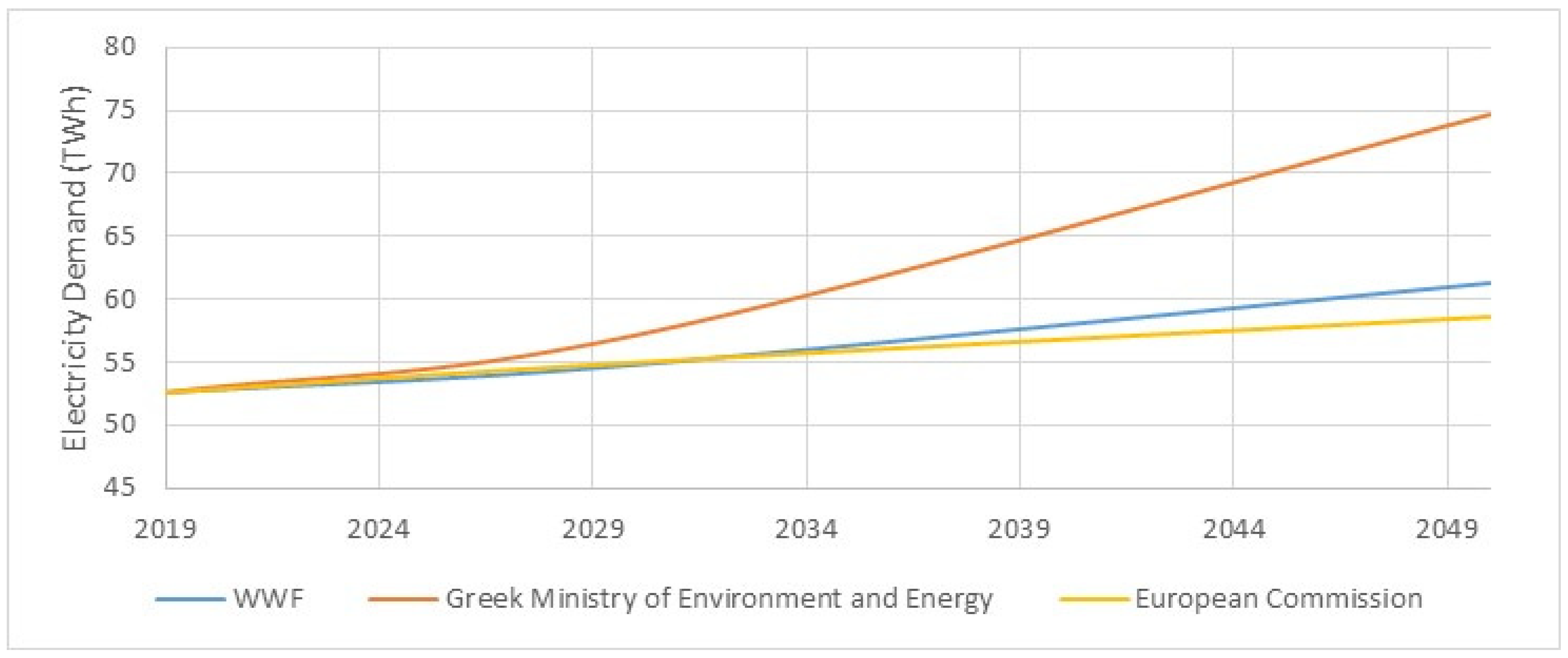Is the Large-Scale Development of Wind-PV with Hydro-Pumped Storage Economically Feasible in Greece?
Abstract
1. Introduction
1.1. Background
1.2. Recent Situation and Trends
2. The Greek Power System
2.1. Current Power System Situation in Greece
2.2. Prospects for the Future
2.3. Wind and PV Development
3. Methodological Approach
3.1. A Simplified Simulation of the Greek Power System
3.1.1. Step 1. PV Power Absorbed in Priority
3.1.2. Step 2. Conventional Units Commitment
3.1.3. Step 3. Wind Power Absorbed and Curtailed
3.1.4. Step 4. Hydropower Output and Hydro-Pumped Storage
3.2. Wind Data—Mesoscale Modeling
3.3. Load Demand Data
3.4. PV Data
4. Application—Results
4.1. Scenarios
4.2. Energy Mix by 2030 and 2050
4.3. Economic Assessment
5. Discussion and Conclusions
Author Contributions
Funding
Institutional Review Board Statement
Informed Consent Statement
Data Availability Statement
Conflicts of Interest
References
- Weitemeyer, S.; Kleinhans, D.; Vogt, T.M.; Agert, C. Integration of Renewable Energy Sources in future power systems: The role of storage. Renew. Energy 2015, 75, 14–20. [Google Scholar] [CrossRef]
- Loisel, R.; Mercier, A.; Gatzen, C.; Elms, N.; Petric, H. Valuation framework for large scale electricity storage in a case with wind curtailment. Energy Policy 2010, 38, 7323–7337. [Google Scholar] [CrossRef]
- Tuohy, A.; O’Malley, M. Pumped storage in systems with very high wind penetration. Energy Policy 2011, 39, 1965–1974. [Google Scholar] [CrossRef]
- Zhang, N.; Lu, X.; McElroy, M.B.; Nielsen, C.P.; Chen, X.; Deng, Y.; Kang, C. Reducing curtailment of wind electricity in China by employing electric boilers for heat and pumped hydro for energy storage. Appl. Energy 2016, 184, 987–994. [Google Scholar] [CrossRef]
- Kong, Y.; Kong, Z.; Liu, Z.; Wei, C.; Zhang, J.; An, G. Pumped storage power stations in China: The past, the present, and the future. Renew. Sustain. Energy Rev. 2017, 71, 720–731. [Google Scholar] [CrossRef]
- Anagnostopoulos, J.S.; Papantonis, D.E. Study of pumped storage schemes to support high RES penetration in the electric power system of Greece. Energy 2012, 45, 416–423. [Google Scholar] [CrossRef]
- Caralis, G.; Rados, K.; Zervos, A. On the market of wind with hydro-pumped storage systems in autonomous Greek islands. Renew. Sustain. Energy Rev. 2010, 14, 2221–2226. [Google Scholar] [CrossRef]
- Tigas, K.; Giannakidis, G.; Mantzaris, J.; Lalas, D.; Sakellaridis, N.G.; Nakos, C.; Vougiouklakis, Y.; Theofilidi, M.; Pyrgioti, E.; Alexandridis, A.T. Wide scale penetration of renewable electricity in the Greek energy system in view of the European decarbonization targets for 2050. Renew. Sustain. Energy Rev. 2015, 42, 158–169. [Google Scholar] [CrossRef]
- Cannistraro, G.; Cannistraro, M.; Trovato, G. Island “Smart Energy” for Eco-Sustainable Energy—A Case Study “Favignana Island”. Int. J. Heat Technol. 2017, 35. [Google Scholar] [CrossRef]
- Lopes, A.S.; Castro, R.; De Jesus, J.F. Contributions to the preliminary assessment of a Water Pumped Storage System in Terceira Island (Azores). J. Energy Storage 2016, 6, 59–69. [Google Scholar] [CrossRef]
- Padrón, S.; Medina, J.F.; Rodriguez, A. Analysis of a pumped storage system to increase the penetration level of renewable energy in isolated power systems. Gran Canaria: A case study. Energy 2011, 36, 6753–6762. [Google Scholar] [CrossRef]
- Bueno, C.; Carta, J. Technical–economic analysis of wind-powered pumped hydrostorage systems. Part II: Model application to the island of El Hierro. Sol. Energy 2005, 78, 396–405. [Google Scholar] [CrossRef]
- Caralis, G.; Zervos, A. Analysis of the combined use of wind and pumped storage systems in autonomous Greek islands. IET Renew. Power Gener. 2007, 1, 49–60. [Google Scholar] [CrossRef]
- Katsaprakakis, D.A.; Christakis, D.G.; Zervos, A.; Papantonis, D.; Voutsinas, S. Pumped storage systems introduction in isolated power production systems. Renew. Energy 2008, 33, 467–490. [Google Scholar] [CrossRef]
- Krajačić, G.; Duić, N.; Tsikalakis, A.; Zoulias, M.; Caralis, G.; Panteri, E.; da Graça Carvalho, M. Feed-in tariffs for promotion of energy storage technologies. Energy Policy 2011, 39, 1410–1425. [Google Scholar] [CrossRef]
- Hu, J.; Harmsen, R.; Crijns-Graus, W.; Worrell, E.; Broek, M.V.D. Identifying barriers to large-scale integration of variable renewable electricity into the electricity market: A literature review of market design. Renew. Sustain. Energy Rev. 2018, 81, 2181–2195. [Google Scholar] [CrossRef]
- Child, M.; Bogdanov, D.; Breyer, C. The role of storage technologies for the transition to a 100% renewable energy system in Europe. Energy Procedia 2018, 155, 44–60. [Google Scholar] [CrossRef]
- Rasmussen, M.G.; Andresen, G.B.; Greiner, M. Storage and balancing synergies in a fully or highly renewable pan-European power system. Energy Policy 2012, 51, 642–651. [Google Scholar] [CrossRef]
- Hunt, J.D.; Zakeri, B.; Lopes, R.; Barbosa, P.S.F.; Nascimento, A.; De Castro, N.J.; Brandão, R.; Schneider, P.S.; Wada, Y. Existing and new arrangements of pumped-hydro storage plants. Renew. Sustain. Energy Rev. 2020, 129, 109914. [Google Scholar] [CrossRef]
- Stocks, M.; Stocks, R.; Lu, B.; Cheng, C.; Blakers, A. Global Atlas of Closed-Loop Pumped Hydro Energy Storage. Joule 2021, 5, 270–284. [Google Scholar] [CrossRef]
- Cheng, C.; Blakers, A.; Stocks, M.; Lu, B. Pumped hydro energy storage and 100 % renewable electricity for East Asia. Glob. Energy Interconnect. 2019, 2, 386–392. [Google Scholar] [CrossRef]
- Dubbers, D. Comparison of underwater with conventional pumped hydro-energy storage systems. J. Energy Storage 2021, 35, 102283. [Google Scholar] [CrossRef]
- Challenges and Opportunities for New Pumped Storage Development—A White Paper Developed by NHA’s Pumped Storage Development Council. Available online: http://www.hydro.org/wp-content/uploads/2012/07/NHA_PumpedStorage_071212b1.pdf (accessed on 15 September 2017).
- Greek Operator of Electricity Market. DAS Monthly Report; Greek Operator of Electricity Market: Athens, Greece, 2019. (In Greek) [Google Scholar]
- DAPEEP. RES and CHP Report; DAPEEP: Athens, Greece, 2019. [Google Scholar]
- Ministry of Environment and Energy. National Energy and Climate Plan; Ministry of Environment and Energy: Athens, Greece, 2019.
- Greek Ministry of Energy and Environment. National Energy Planning, 2050 Energy Roadmap; Greek Ministry of Energy and Environment: Athens, Greece, 2019.
- Capros, P.; de Vita, A.; Tasios, N.; Siskos, P.; Kannavou, M.; Petropoulos, A.; Evangelopoulou, S.; Zampara, M.; Papadopoulos, D.; Nakos, L.; et al. EU Reference Scenario 2016, Energy, transport and GHG emissions Trends to 2050; European Commission: Luxembourg, 2016. [Google Scholar]
- Moirasgentis, S.; Sarafidis, G.; Georgopoulou, E. Long Term Plan for the Greek Energy System; WWF: Athens, Greece, 2017. (In Greek) [Google Scholar]
- Tuohy, A.; Meibom, P.; Denny, E.; O’Malley, M. Unit Commitment for Systems with Significant Wind Penetration. IEEE Trans. Power Syst. 2009, 24, 592–601. [Google Scholar] [CrossRef]
- Ruiz, P.A.; Philbrick, C.R.; Sauer, P.W. Modeling approaches for computational cost reduction in stochastic unit commitment formulations. IEEE Trans. Power Syst. 2010, 25, 588–589. [Google Scholar] [CrossRef]
- Lujano-Rojas, J.; Osório, G.; Catalão, J. New probabilistic method for solving economic dispatch and unit commitment problems incorporating uncertainty due to renewable energy integration. Int. J. Electr. Power Energy Syst. 2016, 78, 61–71. [Google Scholar] [CrossRef]
- Osório, G.; Lujano-Rojas, J.; Matias, J.; Catalão, J.P.S. A probabilistic approach to solve the economic dispatch problem with intermittent renewable energy sources. Energy 2015, 82, 949–959. [Google Scholar] [CrossRef]
- Caralis, G.; Perivolaris, Y.; Rados, K.; Zervos, A. On the Effect of Spatial Dispersion of Wind Power Plants on the Wind Energy Capacity Credit in Greece. Environ. Res. Lett. 2008, 3, 015003. [Google Scholar] [CrossRef]
- Caralis, G.; Papantonis, D.; Zervos, A. The role of pumped storage systems towards the large scale wind integration in the Greek power supply system. Renew. Sustain. Energy Rev. 2012, 16, 2558–2565. [Google Scholar] [CrossRef]
- Papathanassiou, S.A.; Boulaxis, N.G. Power limitations and energy yield evaluation for wind farms operating in island systems. Renew. Energy 2006, 31, 457–479. [Google Scholar] [CrossRef]
- Archer, C.L.; Jacobson, M.Z. Spatial and temporal distributions of U.S. winds and wind power at 80 m derived from measurements. J. Geophys. Res. Space Phys. 2003, 108, 9. [Google Scholar] [CrossRef]
- Kotroni, V.; Lagouvardos, K.; Lykoudis, S. High-resolution model-based wind atlas for Greece. Renew. Sustain. Energy Rev. 2014, 30, 479–489. [Google Scholar] [CrossRef]
- Kotroni, V.; Lagouvardos, K. Evaluation of MM5 High-Resolution Real-Time Forecasts over the Urban Area of Athens, Greece. J. Appl. Meteorol. 2004, 43, 1666–1678. [Google Scholar] [CrossRef]
- Kotroni, V.; Lagouvardos, K. Precipitation forecast skill of different convective parameterization and micro-physical schemes: Application for the cold season over Greece. Geoph. Res. Let. 2001, 108, 1977–1980. [Google Scholar] [CrossRef]
- Akylas, E.; Kotroni, V.; Lagouvardos, K. Sensitivity of high-resolution operational weather forecasts to the choice of the planetary boundary layer scheme. Atmos. Res. 2007, 84, 49–57. [Google Scholar] [CrossRef]
- Troen, I.; Lundtang Petersen, E. European Wind Atlas. Risø National Laboratory. 1989. Available online: Orbit.dtu.dk/files/112135732/European_Wind_Atlas.pdf (accessed on 15 February 2021).
- Caralis, G.; Gao, Z.; Yang, P.; Huang, M.; Zervos, A.; Rados, K. Development of Aeolian map of China using mesoscale atmospheric modelling. Renew. Energy 2015, 74, 60–69. [Google Scholar] [CrossRef]
- Photovoltaic Geographical Information System (PVGIS). Geographical Assessment of Solar Resource and Performance of Photovoltaic Technology. Available online: http://re.jrc.ec.europa.eu/pvgis/ (accessed on 15 September 2017).
- Independent Power Transmission Operator. Power Adequacy Study for Years 2020–2030; Independent Power Transmission Operator: Athens, Greece, 2019. [Google Scholar]
- Papaefthymiou, G.; Grave, K.; Dragoon, K. Flexibility Options in Electricity Systems; Ecofys: Berlin, Germany, 2014. [Google Scholar]
- Larsson, S. Reviewing Electricity Generation; Uppsala Universitet: Uppsala, Sweden, 2012. [Google Scholar]
- Schröder, A.; Kunz, F.; Meiss, J.; Mendelevitch, R.; Hirschhausen, C.V. Current and Prospective Costs of Electricity Generation until 2050; DIW: Berlin, Germany, 2013. [Google Scholar]
- Joint Research Centre. Energy Technology Reference Indicator Projections for 2010–2050; European Union: Luxembourg, 2014. [Google Scholar]
- International Energy Agency; Nuclear Energy Agency. Projected Costs of Generating Electricity; IEA: Paris, France; NEA: Paris, France, 2015.
- Zach, K.; Auer, H.; Lettner, G. Report summarizing the current Status, Role and Costs of Energy Storage Technologies; WIP Renewable Energies: Munich, Germany, 2012. [Google Scholar]
- ECOFYS. Subsidies and Costs of EU Energy, Annex 4–5; European Commission: Brussels, Belgium, 2014. [Google Scholar]
- Ministry of Environment & Energy. Description of Functional Support Scheme in the Renewable Energy Sources and Cogeneration Power and Heat High Performance; Ministry of Environment & Energy: Athens, Greece, 2016.
- Official Government Gazette of Hellenic Republic. Determination of the Minimum Bid Price of Auctioned Energy for the Year 2017; n. Β’ 2278/04.07.2017; Government of Greece: Athens, Greece, 2017; p. 23014. (In Greek)
- International Renewable Energy Agency (IRENA). Renewable Energy Technologies: Cost Analysis Series, Wind Power; IRENA: Bonn, Germany, 2012.
- Lako, P. Hydropower; IEA ETSAP: Paris, France, 2010. [Google Scholar]
- IEA ETSAP. Combined Heat and Power, Technology Brief E04; IEA ETSAP: Paris, France, 2010. [Google Scholar]
- International Renewable Energy Agency. Renewable Energy Technologies: Cost Analysis Series, Biomass for Power Generation; IRENA: Bonn, Germany, 2012.
- Booz & Company. Understanding Lignite Generation Costs in Europe; Public Power Corporation S.A.: Athens, Greece, 2012. [Google Scholar]
- Eleutheriadis, I. Biomass Potential and Solid Biofuels; Center for Renewable Energy Sources and Saving: Athens, Greece, January 2013. [Google Scholar]
- EUBIA, European Biomass Industry Association. 2017. Available online: http://www.eubia.org/cms/wiki-biomass/biomass-characteristics/ (accessed on 15 June 2017).
- Official Government Gazette of Hellenic Republic. Measures to Support and Develop the Greek Economy in the Framework of Application of Law 4046/2012 and Other Provisions; n. 4254/07.04.2014; Government of Greece: Athens, Greece, 2014. (In Greek)
- IEA. IEA Energy Technology Essentials; IEA: Paris, France, 2007.
- Chiantore, P.V.; Gordon, I.; Hoffmann, W.; Perezagua, E.; Philipps, S.; Roman, E.; Sandre, E.; Sink, W.; Simonot, E.; Martínez, A. Future Renewable Energy Costs: Solar Photovoltaics; KIC InnoEnergy: Eindhoven, The Netherlands, 2015. [Google Scholar]
- Mayer, J.N. Current and Future Cost of Photovoltaics; Agora Energiewende: Berlin, Germany, 2015. [Google Scholar]
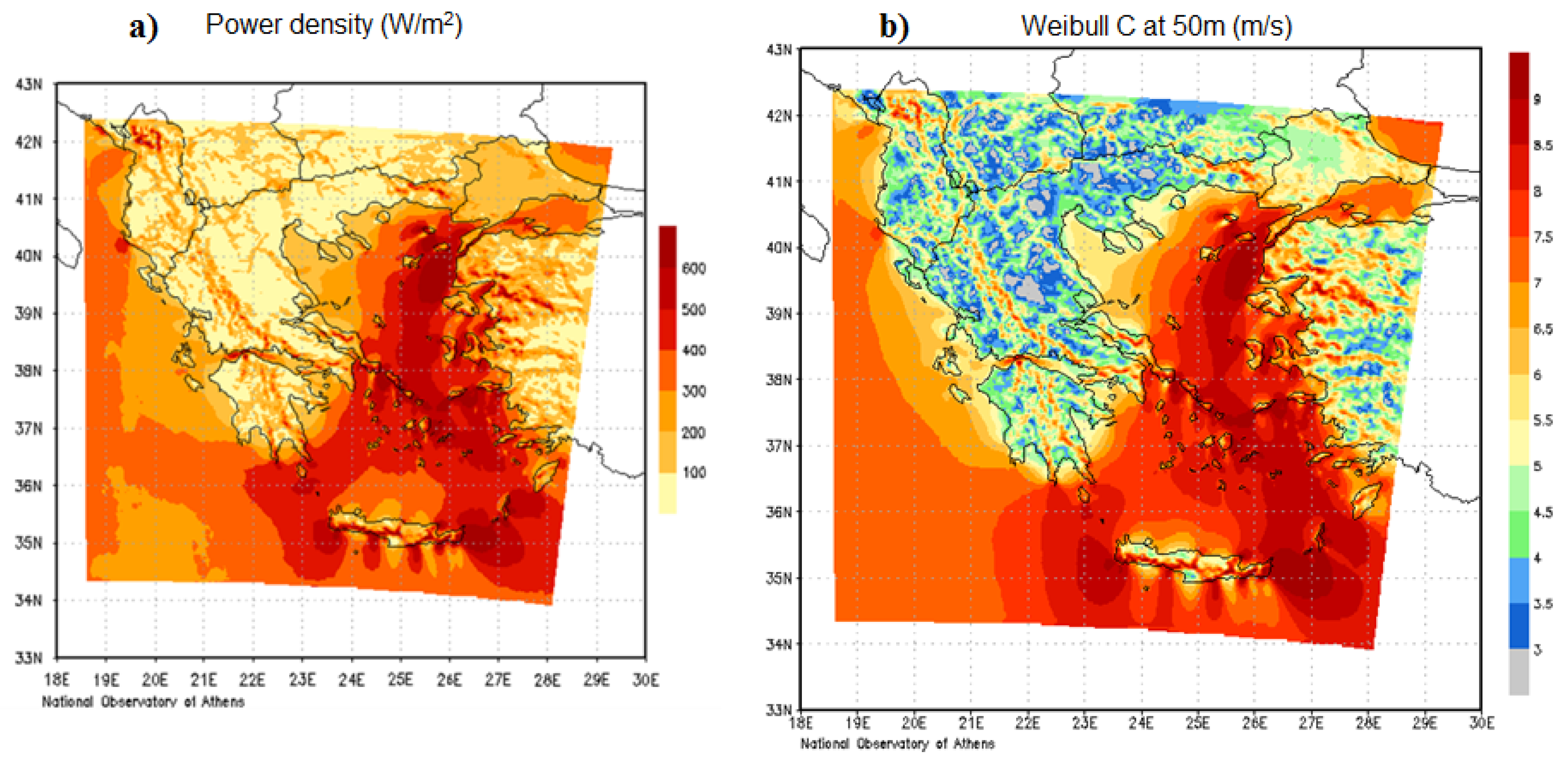
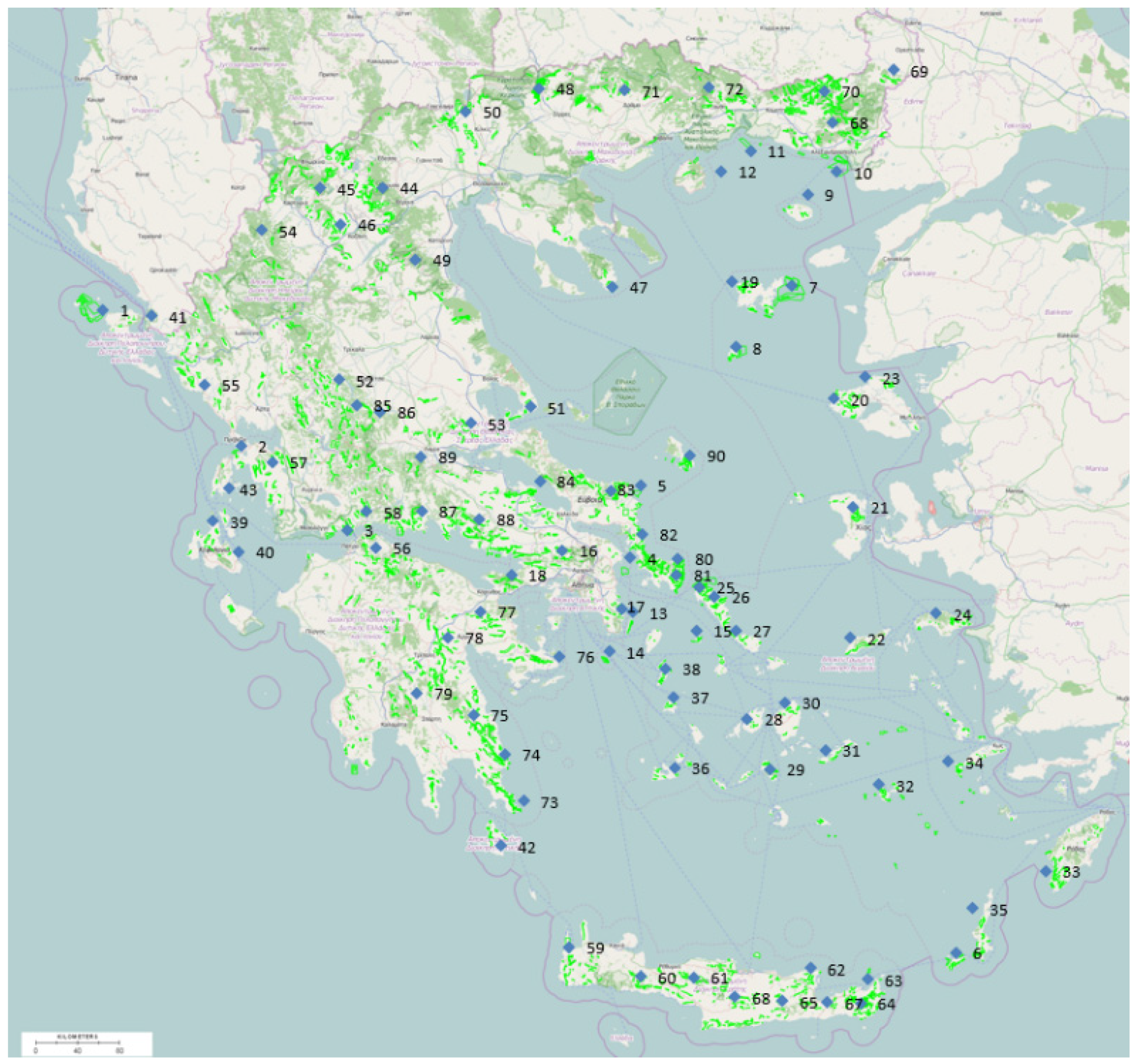
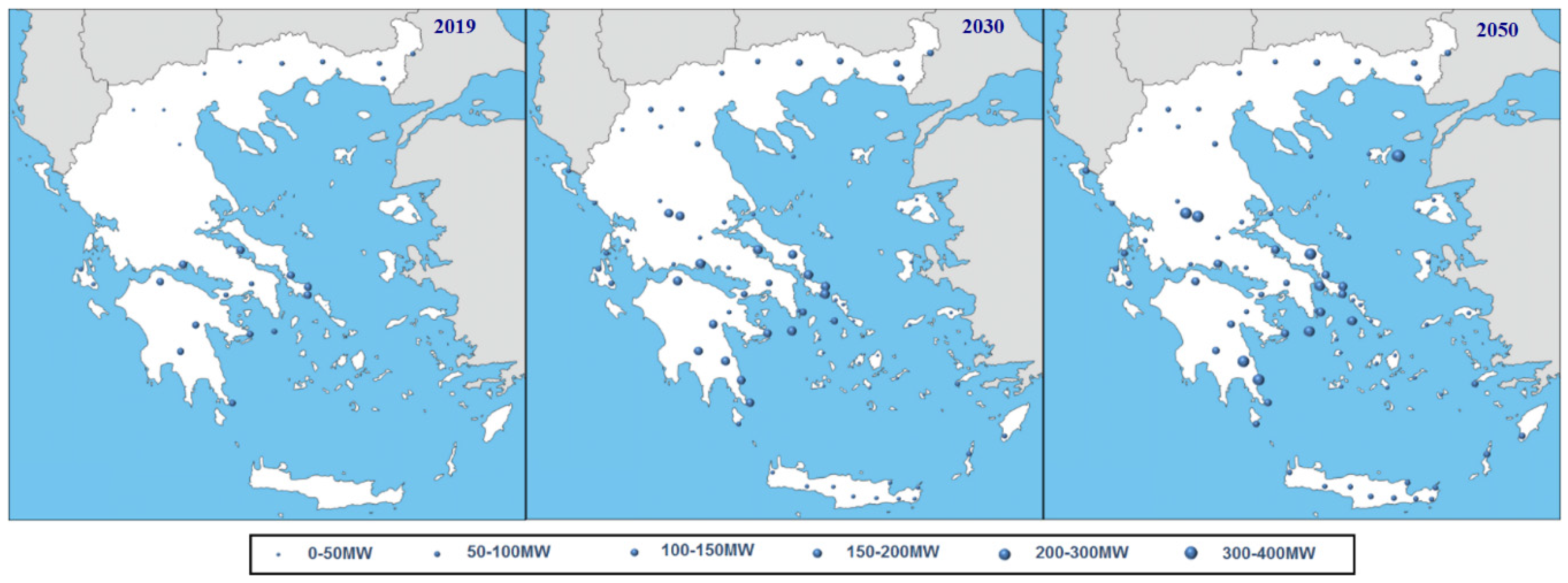
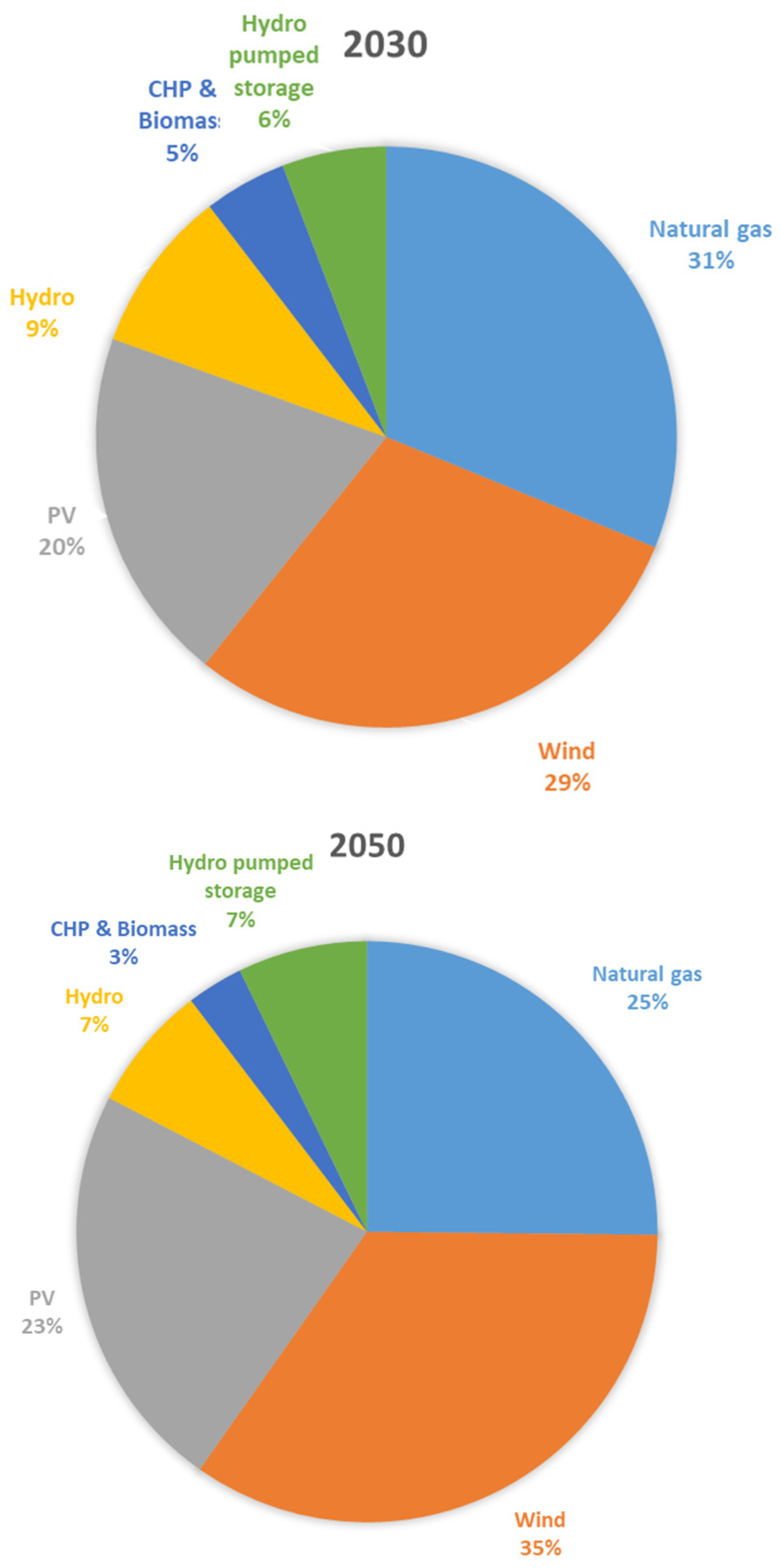
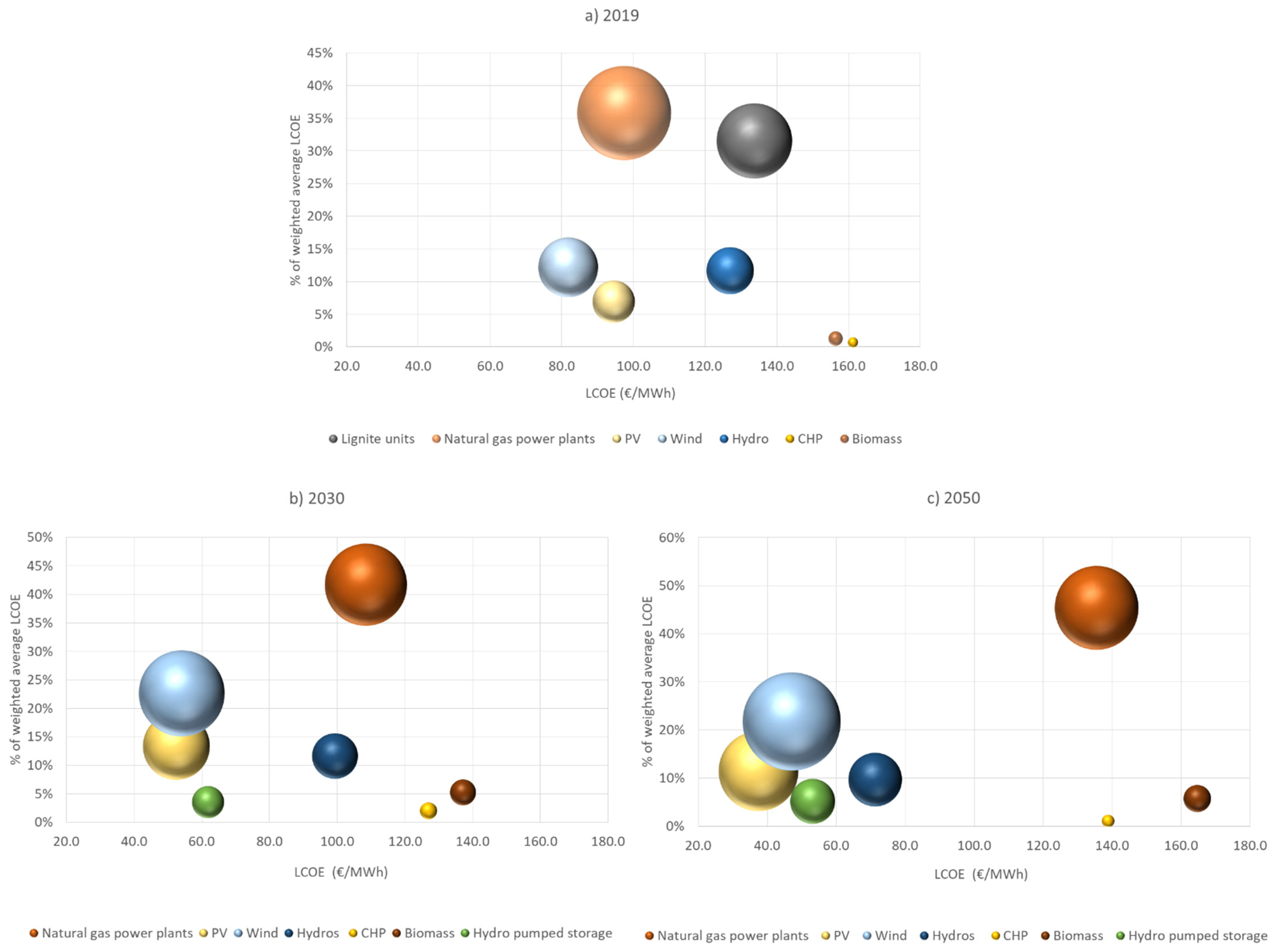
| Ministry of Environment and Energy | WWF | European Commission | ||||
|---|---|---|---|---|---|---|
| PV (GW) | Wind (GW) | PV (GW) | Wind (GW) | PV (GW) | Wind (GW) | |
| 2030 | 7.7 | 7 | 4.8 | 5.0 | 5.6 | 6 |
| 2050 | 8–12 | 11–18 | 7.1 | 6.7 | 8.9 | 7.8 |
| Point | Site | Lat (°) | Long (°) | k (-) | c (m/s) | Wind Power Density (W/m2) | Point | Site | Lat (°) | Long (°) | k (Weibull Coefficient) | c (m/s) | Wind Power Density (W/m2) |
|---|---|---|---|---|---|---|---|---|---|---|---|---|---|
| 1 | Othonoi | 39.786 | 19.422 | 1.59 | 5.99 | 232 | 46 | Kozani | 40.368 | 21.545 | 1.58 | 4.78 | 116 |
| 2 | Lefkada | 38.867 | 20.652 | 1.71 | 5.37 | 146 | 47 | Chalkidiki | 39.947 | 23.972 | 1.73 | 5.35 | 143 |
| 3 | Krioneri | 38.292 | 21.602 | 1.21 | 5.78 | 339 | 48 | Serres | 41.296 | 23.317 | 1.49 | 4.63 | 116 |
| 4 | Petalioi | 38.103 | 24.133 | 1.8 | 7.41 | 369 | 49 | Veroia | 40.127 | 22.214 | 1.59 | 4.47 | 92 |
| 5 | Kimi | 38.599 | 24.221 | 1.75 | 6.68 | 278 | 50 | Kilkis | 41.134 | 22.663 | 1.39 | 4.53 | 127 |
| 6 | Karpathos | 35.417 | 27.039 | 1.91 | 8.92 | 592 | 51 | Trikeri | 39.126 | 23.237 | 1.77 | 5.33 | 137 |
| 7 | Lemnos | 39.951 | 25.573 | 1.69 | 7.62 | 431 | 52 | Trikala | 39.312 | 21.525 | 1.51 | 6.16 | 273 |
| 8 | Ai-Stratis | 39.536 | 25.071 | 1.8 | 7.25 | 344 | 53 | Anavra | 39.017 | 22.705 | 1.65 | 5.06 | 128 |
| 9 | Samothraki | 40.575 | 25.714 | 1.5 | 5.96 | 251 | 54 | Ioannina | 40.327 | 20.837 | 1.72 | 5.8 | 186 |
| 10 | Alexandroupoli | 40.726 | 25.977 | 1.63 | 6.4 | 272 | 55 | Perdika | 39.278 | 20.328 | 1.52 | 4.21 | 83 |
| 11 | Fanari | 40.867 | 25.205 | 1.52 | 5.07 | 150 | 56 | Kalavrita | 38.751 | 20.933 | 1.5 | 5.18 | 164 |
| 12 | Thasos | 40.733 | 24.946 | 1.55 | 5.09 | 145 | 57 | Mitikas | 38.417 | 21.773 | 1.75 | 5.2 | 129 |
| 13 | Makronisos | 37.732 | 24.150 | 1.66 | 7.22 | 379 | 58 | Naupaktos | 38.174 | 21.856 | 1.55 | 5.81 | 221 |
| 14 | Ai-Giorgis | 37.465 | 23.942 | 1.68 | 6.77 | 307 | 59 | Kissamos | 35.455 | 23.587 | 1.63 | 6.55 | 290 |
| 15 | Gyaros | 37.609 | 24.723 | 1.61 | 7.4 | 422 | 60 | Sfakia | 35.258 | 24.225 | 1.43 | 7.78 | 554 |
| 16 | Erithres | 38.151 | 23.525 | 1.56 | 6.23 | 268 | 61 | Psiloreitis | 35.250 | 24.697 | 1.59 | 7.39 | 429 |
| 17 | Lavrio | 37.755 | 24.058 | 1.7 | 7.25 | 372 | 62 | Elounta | 35.312 | 25.740 | 1.7 | 8.2 | 526 |
| 18 | Geraneia | 37.985 | 23.067 | 1.43 | 5.87 | 261 | 63 | Toplou | 35.239 | 26.250 | 1.74 | 7.34 | 374 |
| 19 | Lemnos (Mirina) | 39.983 | 25.043 | 1.73 | 5.95 | 199 | 64 | Ziros | 35.078 | 26.188 | 1.59 | 8.6 | 638 |
| 20 | Lesvos (Eresos) | 39.183 | 25.947 | 1.86 | 6.52 | 239 | 65 | Malia | 35.090 | 25.492 | 1.54 | 8.24 | 594 |
| 21 | Chios | 38.447 | 26.126 | 1.85 | 7.45 | 363 | 66 | Irakleio (south) | 35.117 | 25.068 | 1.59 | 6.52 | 299 |
| 22 | Ikaria | 37.559 | 26.096 | 1.37 | 8.26 | 662 | 67 | Mochlos | 35.080 | 25.896 | 1.49 | 8.73 | 699 |
| 23 | Lesvos (Mantamados) | 39.331 | 26.228 | 1.76 | 6.57 | 263 | 68 | Alexandroupoli | 41.063 | 25.942 | 1.78 | 6.74 | 280 |
| 24 | Samos | 37.724 | 26.865 | 1.66 | 7.37 | 402 | 69 | Orestiada | 41.418 | 26.481 | 1.45 | 4.39 | 104 |
| 25 | Andros (Kalivbarni) | 37.903 | 24.750 | 1.77 | 7.23 | 349 | 70 | Dokos | 41.273 | 25.867 | 1.91 | 6.36 | 214 |
| 26 | Andros (Arnas) | 37.840 | 24.885 | 1.56 | 7.86 | 518 | 71 | Drama | 41.280 | 24.083 | 1.49 | 4.12 | 80 |
| 27 | Tinos | 37.607 | 25.073 | 1.64 | 7.42 | 417 | 72 | Xanthi | 41.298 | 24.828 | 1.63 | 5.52 | 173 |
| 28 | Paros | 37.009 | 25.178 | 1.61 | 7.07 | 372 | 73 | Velanidi | 36.448 | 23.176 | 1.66 | 7.4 | 408 |
| 29 | Ios | 36.664 | 25.375 | 1.75 | 7.74 | 433 | 74 | Monemvasia | 36.768 | 23.013 | 1.52 | 6.9 | 374 |
| 30 | Naxos | 37.117 | 25.514 | 1.81 | 7.54 | 386 | 75 | Kosmas | 37.038 | 22.730 | 1.49 | 6.37 | 308 |
| 31 | Amorgos | 36.797 | 25.873 | 1.82 | 8.32 | 510 | 76 | Argolida | 37.431 | 23.497 | 1.61 | 6.48 | 286 |
| 32 | Astipalaia | 36.559 | 26.354 | 1.81 | 7.54 | 385 | 77 | Sofiko | 37.737 | 22.794 | 1.44 | 5.02 | 161 |
| 33 | Rodos | 35.976 | 27.840 | 1.72 | 6.68 | 285 | 78 | Tripoli | 37.562 | 22.504 | 1.44 | 5.81 | 252 |
| 34 | Kos | 36.715 | 26.972 | 1.87 | 7.79 | 408 | 79 | Kalamata | 37.184 | 22.229 | 1.64 | 4.95 | 121 |
| 35 | Karapthos (Mesochori) | 35.718 | 27.190 | 1.84 | 8.89 | 610 | 80 | Kavo Doro | 38.099 | 24.556 | 1.62 | 7.31 | 405 |
| 36 | Milos | 36.678 | 24.525 | 1.84 | 7.17 | 324 | 81 | Potami | 37.989 | 24.546 | 1.71 | 7.64 | 430 |
| 37 | Sifnos | 37.158 | 24.520 | 1.58 | 7.49 | 446 | 82 | Stira | 38.264 | 24.240 | 1.62 | 6.64 | 305 |
| 38 | Serifos | 37.347 | 24.444 | 1.73 | 7.34 | 376 | 83 | Kimi | 38.556 | 23.957 | 1.7 | 6.92 | 322 |
| 39 | Kefalonia (Atheras) | 38.352 | 20.402 | 1.63 | 5.22 | 145 | 84 | Larimna | 38.622 | 23.322 | 1.63 | 4.98 | 125 |
| 40 | Kefalonia (Ainos) | 38.146 | 20.633 | 1.55 | 5.21 | 158 | 85 | Karpenisi | 39.141 | 21.686 | 1.66 | 6.35 | 258 |
| 41 | Kerkira | 39.747 | 19.856 | 1.37 | 4.34 | 114 | 86 | Fourna | 39.098 | 21.899 | 1.75 | 4.77 | 98 |
| 42 | Kithira | 36.144 | 22.974 | 1.72 | 7.81 | 455 | 87 | Lidoriki | 38.421 | 22.269 | 1.39 | 5.88 | 277 |
| 43 | Lefkada | 38.572 | 20.549 | 1.74 | 5.96 | 198 | 88 | Thisvi | 38.366 | 22.785 | 1.68 | 5.6 | 173 |
| 44 | Naousa | 40.618 | 21.922 | 1.69 | 4.91 | 112 | 89 | Mpralos | 38.791 | 22.264 | 1.72 | 5.63 | 169 |
| 45 | Florina | 40.614 | 21.360 | 1.69 | 5.48 | 159 | 90 | Skyros | 38.798 | 24.666 | 1.88 | 7.13 | 311 |
| Peloponnese | Central Greece | Thessaly-Epirus | Macedonia | |
|---|---|---|---|---|
| Annual PV production (kWh/kWp) | 1510 | 1550 | 1300 | 1360 |
| C.F. | 17% | 18% | 15% | 15% |
| 2019 | |||||||
|---|---|---|---|---|---|---|---|
| Technology | Lignite | Natural Gas | PV | Wind | Hydro | CHP | Biomass |
| Nominal power Pnom (MW) | 3904 [27] | 4900 [27] | 2639 [27] | 3283 [27] | 3411 [27] | 105 [27] | 86.89 [27] |
| Produced Energy (GWh) | 10,418 | 16,228 | 3249 | 6565 | 4052 | 186 | 362 |
| CAPEX (€/kW) | 1850 [46,47,48] | 700 [46,47] | 1100 [48,49,50] | 1300 [47,49,50] | 1800 [49,53] | 1100 [53] | 2650 [53] |
| Fixed O&M (€/KW) | 35 [54] | 21 [49] | 22 [49] | 52 [49,55] | 18 [49,56] | 40 [57] | 79.5 [58] |
| Variable O&M (€/MWh) | 2 [48] | 2 [49] | - | - | 2.05 [54] | 2 | 4 [58] |
| Cost (€/tlignite | €/m3 Natural gas) | 17.7 [59] | 0.3 | - | - | - | 0.3 | 130 [58,60] |
| Lower Heating Value (GJ/ tlignite | GJ/ m3 Natural gas) | 5.3 [59] | 0.03 | - | - | - | 0.03 | 19 [58,61] |
| Efficiency (%) | 45% [46] | 60% [46] | - | - | - | 35% [62] | 30% [63] |
| Heat rate (GJ/MWh) | 8.0 | 6.0 | - | - | - | 10.3 | 12.0 |
| Fuel unit cost (€/MWh) | 27 | 60 | - | - | - | 103 | 82 |
| CO2 emissions (t/Mwh) | 1.5 | 0.5 [49] | - | - | - | - | - |
| CO2 cost (€/t) | 24 [26] | 5 | - | - | - | - | - |
| Carbon Cost (€/MWh) | 36 | 2.5 | - | - | - | - | - |
| Life time (years) | 30 | 30 | 25 | 25 | 50 | 30 | 30 |
| CRF | 0.081 | 0.081 | 0.086 | 0.086 | 0.072 | 0.081 | 0.081 |
| LCOE (€/MWh) | 133.7 | 97.3 | 94.5 | 81.8 | 127.0 | 161.2 | 156.3 |
| Weighted average LCOE (€/MWh) | 107.59 | ||||||
| 2030 | |||||||
|---|---|---|---|---|---|---|---|
| Technology | Natural Gas | PV | Wind | PHS | Hydro | CHP | Biomass |
| Nominal power Pnom (MW) | 6970 | 8000 | 8000 | 1500 | 3411 | 125 | 300 |
| Produced Energy (GWh) | 17,086 | 11,293 | 18,624 | 2545 | 5203 | 705 | 1692 |
| CAPEX (€/kW) | 700 | 700 [64,65] | 1000 [49] | 1200 [51] | 1800 | 1100 | 2650 |
| Fixed O&M (€/KW) | 21 | 14 | 40 | 18 | 18 | 40 | 79.5 |
| Variable O&M (€/MWh) | 2 | - | - | - | 2.05 | 2 | 3.2 |
| Cost (€/tlignite | €/m3 Natural gas) | 0.3 | - | - | - | - | 0.3 | 130 |
| Lower Heating Value (GJ/ tlignite | GJ/ m3 Natural gas) | 0.03 | - | - | - | - | 0.03 | 19 |
| Efficiency (%) | 60% | - | - | - | - | 35% | 30% |
| Heat rate (GJ/MWh) | 6.0 | - | - | - | - | 10.3 | 12.0 |
| Fuel unit cost (€/MWh) | 60 | - | - | - | - | 103 | 82 |
| CO2 emissions (t/Mwh) | 0.5 | - | - | - | - | 0.5 | - |
| CO2 cost (€/t) | 30 [27] | - | - | - | - | 0 | - |
| Carbon Cost (€/MWh) | 15 | - | - | - | - | 0 | - |
| Life time (years) | 30 | 25 | 25 | 50 | 50 | 30 | 30 |
| CRF | 0.081 | 0.086 | 0.086 | 0.072 | 0.072 | 0.081 | 0.081 |
| LCOE (€/MWh) | 108.5 | 52.5 | 54 | 61.9 | 99.4 | 127 | 137.2 |
| Weighted average LCOE (€/MWh) | 77.86 | ||||||
| 2050 | |||||||
|---|---|---|---|---|---|---|---|
| Technology | Natural Gas | PV | Wind | PHS | Hydro | CHP | Biomass |
| Nominal power Pnom (MW) | 7100 | 12,000 | 12,000 | 2700 | 3565 | 125 | 600 |
| Produced Energy (GWh) | 18638 | 16,924 | 25,620 | 5334 | 5203 | 402 | 1929 |
| CAPEX (€/kW) | 700 | 500 [64,65] | 800 [49] | 1200 | 1800 | 1100 | 2650 |
| Fixed O&M (€/KW) | 21 | 10 | 32 | 18 | 18 | 40 | 79.5 |
| Variable O&M (€/MWh) | 2 | - | - | - | 2.05 | 2 | 3.2 |
| Cost (€/tlignite | €/m3 Natural gas) | 0.3 | - | - | - | - | 0.3 | 130 |
| Lower Heating Value (GJ/ tlignite | GJ/ m3 Natural gas) | 0.03 | - | - | - | - | 0.03 | 19 |
| Efficiency (%) | 60% | - | - | - | - | 35% | 35% |
| Heat rate (GJ/MWh) | 6.0 | - | - | - | - | 10.3 | 10.3 |
| Fuel unit cost (€/MWh) | 60 | - | - | - | - | 103 | 70 |
| CO2 emissions (t/Mwh) | 0.5 | - | - | - | - | 0.5 | - |
| CO2 cost (€/t) | 88 [27] | - | - | - | - | 0 | - |
| Carbon Cost (€/MWh) | 44 | - | - | - | - | 0 | - |
| Life time (years) | 30 | 25 | 25 | 50 | 50 | 30 | 30 |
| CRF | 0.081 | 0.086 | 0.086 | 0.072 | 0.072 | 0.081 | 0.081 |
| LCOE (€/MWh) | 135.5 | 37.5 | 47.1 | 53.1 | 102.6 | 138.9 | 164.6 |
| Weighted average LCOE (€/MWh) | 75.06 | ||||||
Publisher’s Note: MDPI stays neutral with regard to jurisdictional claims in published maps and institutional affiliations. |
© 2021 by the authors. Licensee MDPI, Basel, Switzerland. This article is an open access article distributed under the terms and conditions of the Creative Commons Attribution (CC BY) license (http://creativecommons.org/licenses/by/4.0/).
Share and Cite
Dianellou, A.; Christakopoulos, T.; Caralis, G.; Kotroni, V.; Lagouvardos, K.; Zervos, A. Is the Large-Scale Development of Wind-PV with Hydro-Pumped Storage Economically Feasible in Greece? Appl. Sci. 2021, 11, 2368. https://doi.org/10.3390/app11052368
Dianellou A, Christakopoulos T, Caralis G, Kotroni V, Lagouvardos K, Zervos A. Is the Large-Scale Development of Wind-PV with Hydro-Pumped Storage Economically Feasible in Greece? Applied Sciences. 2021; 11(5):2368. https://doi.org/10.3390/app11052368
Chicago/Turabian StyleDianellou, Anna, Theofanis Christakopoulos, George Caralis, Vassiliki Kotroni, Konstantinos Lagouvardos, and Arthouros Zervos. 2021. "Is the Large-Scale Development of Wind-PV with Hydro-Pumped Storage Economically Feasible in Greece?" Applied Sciences 11, no. 5: 2368. https://doi.org/10.3390/app11052368
APA StyleDianellou, A., Christakopoulos, T., Caralis, G., Kotroni, V., Lagouvardos, K., & Zervos, A. (2021). Is the Large-Scale Development of Wind-PV with Hydro-Pumped Storage Economically Feasible in Greece? Applied Sciences, 11(5), 2368. https://doi.org/10.3390/app11052368








